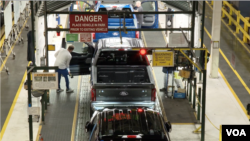All About America explores American culture, politics, trends, history, ideals and places of interest.
America’s best-selling vehicle rolls off the assembly line every 53 seconds at Ford’s Dearborn truck plant in Michigan. More than 41 million F-150s have been sold since the truck was introduced 76 years ago.
“The F series has been the best-selling truck in the U.S. for 47 years, the best-selling vehicle of any kind in the U.S. for 42 years,” says John Emmert, general manager of Ford North America, Trucks.
What makes the truck so popular generation after generation? Vaux Adams, a city employee in Sterling Heights, Michigan, says his father-in-law introduced him to the Ford F-150, and Adams liked it so much he just leased his second one.
“I’m just going to stick with the truck, because I bought a house, and I’ve got to move furniture, got to do yard work, so I needed it,” Adams says. “I really liked the interior and everything, whether it’s from leather to just the cloth seating. I have one with a big touchscreen, which is amazing. I’m a tech guy, so that’s great.”
Ford attributes its success to constant innovation.
“We are always engaging with customers, whether it’s through market research or going out and observing how they use our vehicles or interacting with them in a number of different ways,” Emmert says. “We take all that intelligence, and we develop vehicles, the F-150, to serve their needs at every possible turn.”
The first incarnation of the Ford-150 was created in 1948. Ford was the first to design a pickup truck for average drivers and not just for business utility, according to Kevin Joostema, past president of the Washington Auto Press Association and managing president of Car-Ed, a website that helps consumers decide which vehicle best suits their needs.
“The one product [Ford] seems to always put some of their technology leadership into is the F series for consumers, and that goes all the way up to today,” Joostema says. “Making very consumer-focused choices on what they’re trying to do with the lineup, making the cabs bigger for passengers, changing the styling.”
Joostema says another reason the F-150 is popular is because Ford offers a variety of options to suit individual consumer needs, including options like certain types of engines or larger cabs to fit more passengers.
“It’s really truly hard to think of a con, because it’s the broadest base,” he says. “Even the truck bed. You might say, ‘Well, I want an 8-foot truck bed with the crew cab, and Ford has that. The other ones [truck makers] don’t. So, because it’s the broadest base of offerings, it’s hard to find the thing that it’s missing.”
At the Dearborn plant, trucks are continuously built by 5,200 employees working 10-hour shifts. The final stages of the process include the engine checks, and then there’s the body drop, where key pieces of the truck are married together. The process is checked by both computers and workers on the floor. Humans and machines work in tandem to produce a new truck in under a minute during final assembly.
“You need people to build vehicles. … If you look at all the technology that’s coming out, it’s really about a collaborative space,” says Corey Williams, manager of Ford’s Dearborn truck plant. “Every workstation has its own computer, and it literally assists the operator in a virtual station of making sure we ensure quality.”
Williams points to factors he thinks keep customers coming back decade after decade.
“It’s the technologies. It’s the interior. You’re getting into the interior, and it’s like a luxury vehicle,” Williams says. “You forget that you’re in a truck.”
At the nearby Suburban Ford of Sterling Heights, the F-150 accounts for about half of the dealership’s business, according to general manager Jim Elder, who drives one himself.
“It fits my family’s lifestyle. I don’t work in construction, obviously, but it helps me move bicycles,” Elder says. “If I have to pick something up for the house or tow something small or big, it handles my everyday needs.”
For people worried about gas usage, Ford has developed the all-electric Ford F-150 Lightning.
Joostema and other reviewers do point to poor fuel efficiency — limited miles per gallon — as a downside to owning one of these trucks. But many Americans don’t seem to mind, considering that tens of millions of F-150s have been sold since the 1940s, including 750,789 in the United States in 2023.


